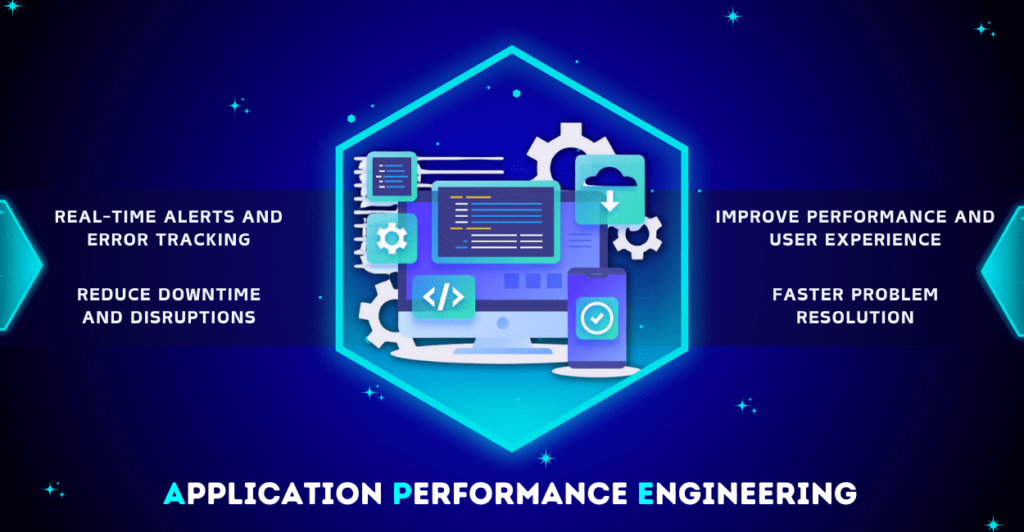In the changing world of software development, ensuring optimal performance is critical. This is where performance engineering comes in not only as a testing phase but as a comprehensive discipline that influences the entire development lifecycle.
Application Performance engineering represents a paradigm shift, recognizing that performance issues cannot be ignored. It takes a proactive and comprehensive approach, recognizing that optimal performance is not simply a desirable goal but necessary for any successful software program.
The changing landscape of software necessitates a comprehensive approach, with performance engineering becoming an intrinsic element of the development philosophy.
It goes beyond reactive problem-solving to develop a culture of performance excellence that anticipates issues, encourages innovation, and guarantees that software not only functions but shines at providing a seamless user experience.

1. The Fundamentals of Application Performance Engineering
Application Performance engineering is a multidimensional field that goes beyond conventional testing methods. It includes the early integration of performance testing, continuous monitoring, and scalability planning.
By implementing performance testing from the start, development teams may proactively detect and address issues, preventing possible bottlenecks from becoming severe problems.
2. Tools, Techniques and Automation
Automation is at the heart of productivity in performance engineering. Automated performance testing solutions simplify the testing process by providing immediate feedback and improving test coverage.
Advanced performance engineering techniques provide nuanced insights into application behavior, which enable more efficient bottleneck identification.
Code profiling tools are highly effective in identifying performance bottlenecks in application code, allowing engineers to optimize vital parts for improved overall efficiency.
3. Collaboration, Communication, and Feedback.
Effective communication
across development, testing, and operations teams is crucial for the success of performance engineering programs. Clear communication ensures everyone understands the performance goals and requirements, producing a collaborative environment promoting success.
Regular performance evaluations and feedback loops are critical tools for analyzing the efficiency of performance engineering initiatives, enabling continuous improvement.
4. Aligning with Engineering Productivity Goals
While performance engineering focuses on optimizing software performance, its goals align with broader engineering efficiency objectives. Engineering productivity assesses and optimizes the entire software engineering process, improving workflow efficiency at each level.
By implementing performance engineering approaches, development teams help to reach performance goals and enhance the overall efficiency of the development process.
5. The Role of Performance Modelling
Performance modeling is an integral part of performance engineering that deserves more recognition. This entails simulating multiple scenarios to forecast application behavior under various circumstances.
Development teams can optimize their systems for maximum effectiveness and adaptability by establishing real-world usage models.
6. Real-time Performance Monitoring
The landscape of performance engineering is now complete with real-time performance monitoring in production scenarios. This entails continually tracking key performance parameters, enabling teams to discover and address issues as they arise.
Real-time tracking provides essential insights into how the application operates under real-world user settings, allowing teams to make data-driven decisions for optimization.
7. The Human Element
Investing in the development team’s skill sets is critical to achieve outstanding performance. Training sessions and knowledge-sharing activities ensure team members are familiar with the most recent performance engineering best practices and tools.
Equipped teams with the necessary abilities are better prepared to face the challenges of optimizing software performance.
Result
Finally, performance engineering is more than just a phase in the software development life cycle; it drives software excellence. The journey from early performance testing integration to continuous monitoring, cooperation, and alignment with overall productivity goals is a comprehensive optimization strategy that enhances the entire software development process.
As technology advances rapidly, the importance of efficient performance engineering approaches becomes more apparent.
In the ever-changing software development world, where user expectations constantly rise, the desire for applications that meet and continuously exceed performance expectations is unavoidable.
Adopting these proactive methods is like using a compass to navigate the difficulties of modern software development.
Development teams cultivate a culture of continuous improvement, resulting in a dynamic environment in which each iteration, code optimization, and collaborative effort contributes to overall program performance enhancements.
In this era of broadened digital experiences, where user satisfaction is the ultimate measure of success, performance engineering is a beacon, guiding development teams to create applications that operate and please users with seamless and efficient experiences.
As development processes change and new technologies emerge, performance engineering principles remain fundamental, ensuring that software keeps up with innovation and leads the road to unprecedented excellence.


